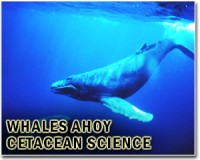 |
Woods Hole MA (SPX) Apr 28, 2011 As they might with most endangered animals, scientists consider the whereabouts and activities of right whales extremely important. "It is helpful to know where they go, why they go there and what they do when they're there," says Mark F. Baumgartner of the biology department at the Woods Hole Oceanographic Institution (WHOI). Baumgartner and his colleagues studied the behavior of right whales and sei whales-both endangered species of baleen whales-in the waters of the Gulf of Maine to the east of Nantucket. They found that the location, the length of stay, and perhaps the very abundance of the whales may be dependent on an interesting vertical migration pattern by the copepods on which the whales feed. It seems to be a case, he said, of "how the behavior of the prey influences the behavior of the whales." The algae-eating copepod, Calanus finmarchicus, appears to migrate up and down in the water column to avoid being eaten by predators such as herring and sand lance. Since these fish need to see their prey in order to feed, copepods often remain at depths where sunlight will not penetrate during the daytime. Under cover of night, they leave this deep, dark refuge, swim to the surface, and feed on algae in relative safety. In turn, this pattern, the scientists report in a recent issue of the journal Marine Ecology Progress Series, has a "dramatic impact" on the behavior and whereabouts of the whales. They found that right whales, which are capable of feeding at depths of 450 to 600 feet below the surface, continued to stay in the area and feed on copepods deep in the water column during the day. The sei whales, on the other hand, were "significantly less abundant" when the copepods displayed vertical migration. Unlike the right whales, the sei whales probably cannot feed at depth during the day, so they may leave the area in search of better feeding conditions elsewhere. For reasons not well understood, the critically endangered right whale is vulnerable to being hit by ships while at the surface. Baumgartner points out that nighttime may prove particularly dangerous for right whales as they feed on copepods that have migrated to the surface, yet captains piloting ships in the dark have no way to see and avoid the whales. "Our study also helps us understand why right whales stick around in this area, from about mid April to mid June," Baumgartner said. Because of their ability to feed below the surface, "they are able to out-compete the herring" for food, he said. It had been thought that the recovery of herring stocks in the last decade might further threaten the right whale by depleting its food supply, Baumgartner said. But these latest observations-along with a rise in the North Atlantic right whale population from roughly 300 to 400 since 1999-suggest that herring recovery does not threaten the right whale population, he said. At the same time, the herring and sand lance, by inducing the copepods' vertical migration behavior, "are likely influencing the distribution and abundance of sei whales" in that area, the researchers report. However, since the sei whale population numbers in the thousands, Baumgartner said their tendency to go elsewhere to look for food is not as great a concern as it would be for the right whale. "The good news is that the recovery of herring stocks is not going to be a problem for the right whale population," Baumgartner said. "The bad news is that if the right whales are feeding at the surface at night, they are at greater risk for ship strikes than we had thought earlier." The study was conducted during the spring seasons of 2005, 2006 and 2007. Baumgartner was joined in the study by Nadine S.J. Lysiak of WHOI and researchers from UMass Boston and the NOAA Northeast Fisheries Science Center in Woods Hole.
Share This Article With Planet Earth
Related Links Woods Hole Oceanographic Institution Follow the Whaling Debate
 Tsunami-hit Japanese whalers set sail for hunt
Tsunami-hit Japanese whalers set sail for huntTokyo (AFP) April 26, 2011 Japanese whalers on Tuesday launched their annual coastal hunt with five crew from the tsunami-devastated whaling town of Ayukawa joining their first voyage since the March 11 disaster. Two whaling vessels left Kushiro on the east coast of the northern island of Hokkaido after their departure was delayed by one day due to bad weather, said Hiroko Furukawa, a fisheries agency official. Th ... read more |
|
| The content herein, unless otherwise known to be public domain, are Copyright 1995-2010 - SpaceDaily. AFP and UPI Wire Stories are copyright Agence France-Presse and United Press International. ESA Portal Reports are copyright European Space Agency. All NASA sourced material is public domain. Additional copyrights may apply in whole or part to other bona fide parties. Advertising does not imply endorsement,agreement or approval of any opinions, statements or information provided by SpaceDaily on any Web page published or hosted by SpaceDaily. Privacy Statement |